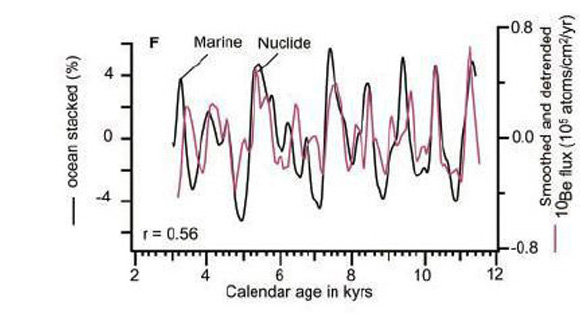| |
宮原 (2014), p.121
氷床は万年雪が積み重なったもので、その重みによってゆっくり前進し、いずれ氷山となって海に流れ出します。
陸域を移動するあいだに大地を削り、その破片を抱えたまま流れていきます。
海に流れ出してある程度南下すると、海水温が比較的高く氷が融ける領域に到達します。
そこで、氷山が融け、それまで抱えていた石を海底に落とすのです。
海底には砂塵やプランクトンなどの生物の死骸などが堆積して地層が形成されていますが、氷山が融けて落とした石もその地層に取り込まれることになります。
このようにして、氷が流れ着いてそこで融けたという証拠が残されるのです。
北大西洋の海底の地層には、そうして陸域から運ばれた石がいくつも含まれていて、「氷河性砕屑物」あるいは「IRD (ice-rafted debris)」と呼ばれています。
|
|
応用
| |
Bond (2001)
Surface winds and surface ocean hydrography in the subpolar North Atlantic appear to have been influenced by variations in solar output through the entire Holocene.
The evidence comes from a close correlation between inferred changes in production rates of the cosmogenic nuclides carbon-14 and beryllium-10 and centennial to millennial time scale changes in proxies of drift ice measured in deep-sea sediment cores.
‥‥‥
Our proxies for changes in Holocene drift ice are the percentages of three petrologic tracers in the small amounts of ice-rafted debris that are ubiquitous in the subpolar North Atlantic: hematite-stained grains (HSG), Icelandic glass (IG), and detrital carbonate (DC).
‥‥‥
[ IRD - 14C]
 [ IRD - 10Be]
[ IRD - 10Be]

|
|
引用文献
宮原ひろ子 (2014) :
『地球の変動はどこまで宇宙で解明できるか』, 化学同人 (DOJIN選書), 2014.
Bond, G. et al. (2001) :
Persistent solar influence on North Atlantic climate during the Holocene
Science, vol.294, 2001
|